Guitar Syntax

The E-system for Guitars and Guitar Syntax
Discover the E-System and Guitar Syntax, a revolutionary approach that unlocks the (mysteries of the) guitar fretboard. The E-System provides a unique perspective using numeric values of intervals (1-7) to unlock the guitar to any key, by giving the key note number 1 and making it the leader – tonal centre. This creates a map in which by using Guitar Syntax you can move across the entire neck, knowing exactly what chord belongs where, according to the diatonic harmony.
Together, they form a cohesive framework that empowers you to construct chords with ease, move across the neck with clarity, and understand the interconnectedness of elements (intervals, scales, modes, shapes, chords) on the guitar.
Many guitarists face the frustration of having to memorize countless chord shapes and scale patterns, feeling constrained by box patterns that limit their ability to navigate the fretboard freely. This often leads to a superficial understanding of how chords are constructed and a reliance on rote memorization rather than true comprehension.
The E-System and Guitar Syntax solve this.
FAQ
How is this different from traditional guitar learning methods?
Unlike traditional methods that rely on memorization, the E-System teaches you that there are only 5 major chord shapes that relate to strings. All other chords are customizations of these shapes, making learning more logical and systematic.
What is the E-System and Guitar Syntax?
It is how the guitar works. Simple numeric system, offering a logical navigation of the fretboard tailored specifically for guitarists.
The E-System is a unique framework that helps you understand the guitar fretboard using numbers 1-7 for intervals, allowing you to understand chord-scale relationship, enabling you to construct rather than memorize chords.
Guitar Syntax is the methodology for applying this system, it is the key to seamless fretboard navigation.
What will I learn ?
Understanding the major scale through numeric values
The ‘5-1-3’ nucleus concept for chord construction
How to create any chord type using simple modifications
Navigate the entire fretboard
Understanding modes without memorizing flats and sharps
Who is this approach good for?
- The System and guitar syntax is excellent for guitarists who want to enhance their understanding of the fretboard.
- Guitarists who are tired of memorizing countless chord shapes and scales, and want a more logical, systematic approach to understanding the fretboard.
- It is ideal for individuals interested in music theory who may find the subject overwhelming and need a simplified approach.
- Open-minded guitar teachers who can learn new and different methods, enabling them to expand their expertise.
Overview – learning path
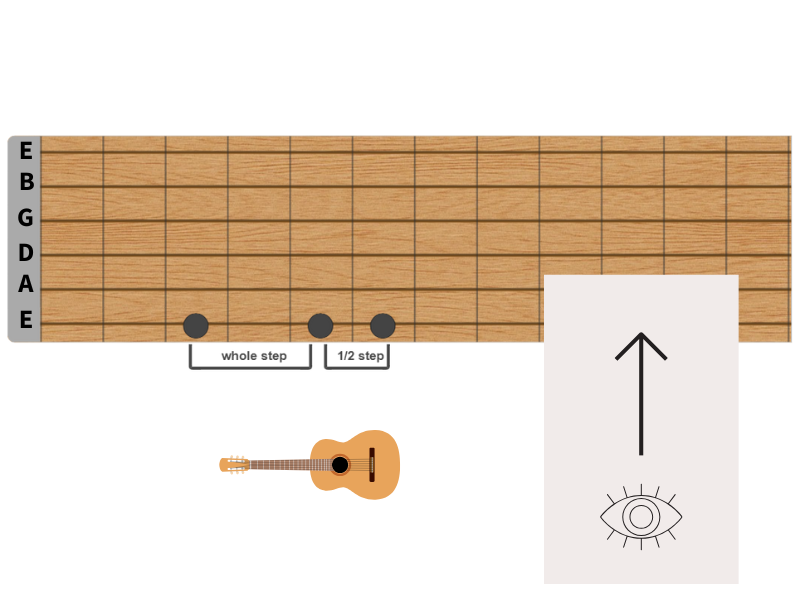
Synchronized look
This diagram shows the guitar fretboard. To understand it, imagine looking at your fretting hand while holding the guitar. The thickest string (the bass E string) is at the bottom of the diagram. We will read the fretboard from bottom to top.
We will read from bottom up.
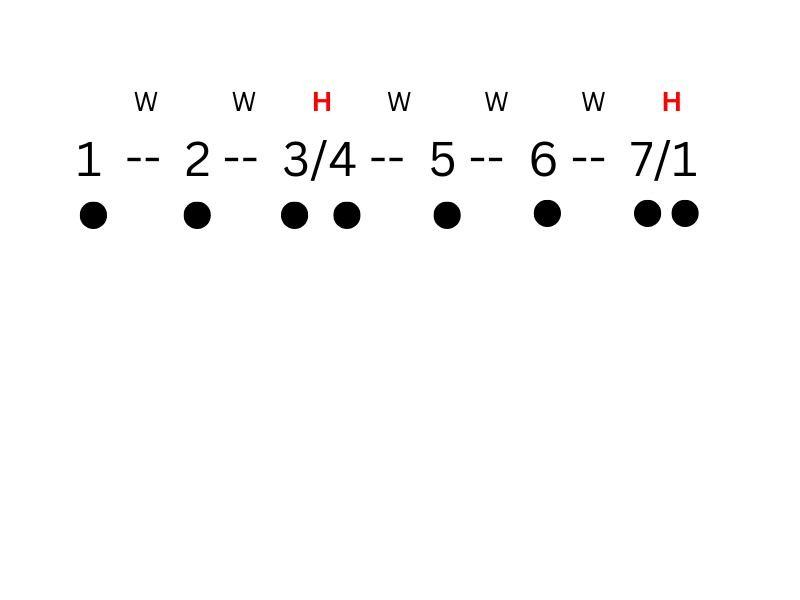
Half step/whole step
To represent the whole and half step intervals that structure a major scale, we use numbers. Notice the spacing between the numbers. The distance between 3 and 4, and 7 and 1, is a half step. Between the other numbers, there is a whole step.
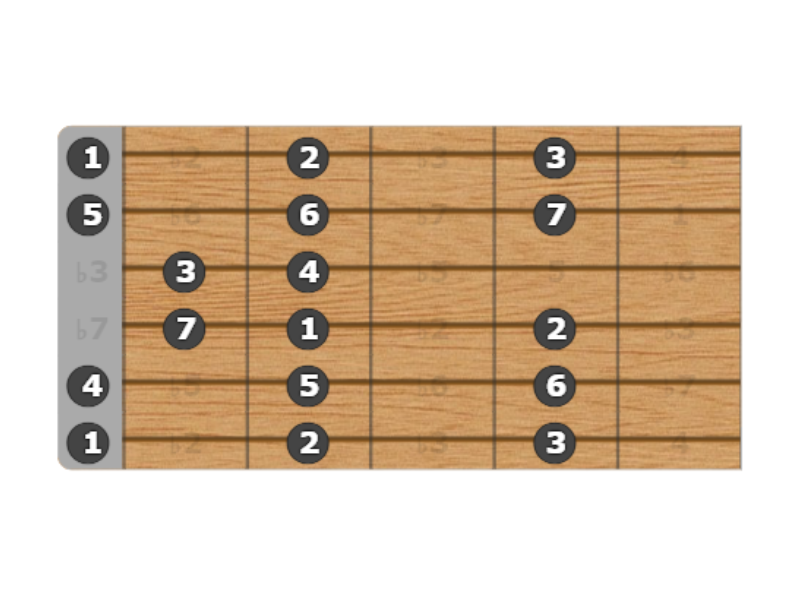
Major scale across the strings
Major scale spanning across the strings – constructed with numbers; we use 3 tones per string except on the G string. We will read from bottom up.”
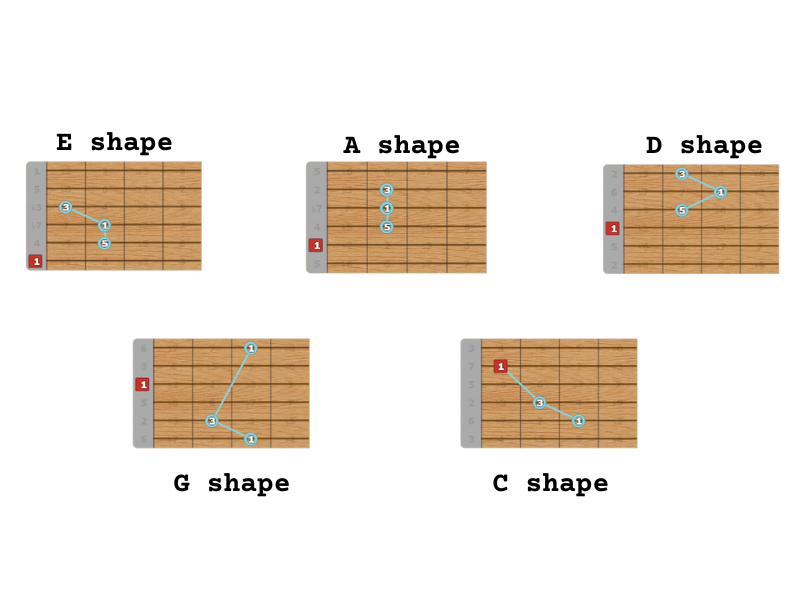
5 major chord shapes
“These five major chord shapes are fundamental building blocks within the E-system. Each shape relates to a specific string. Since the guitar has five strings, there are five corresponding major chord shapes. All other chord types are essentially variations of these five.”
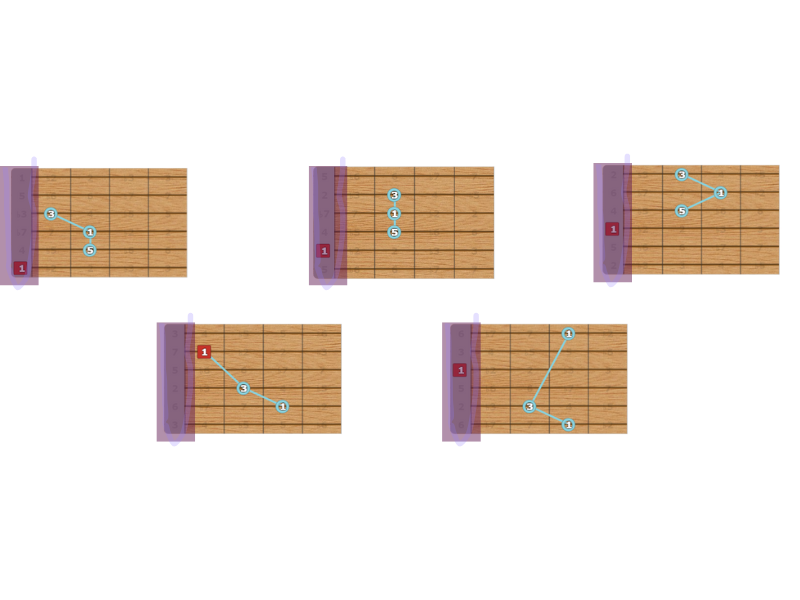
Bare
With “bare,” we can move the shapes. “Bare” also serves as an indicator of the root (number 1 )to which the shape is connected. It allows us to see where the core-nucleus numbers are located, so we can use or modify them.
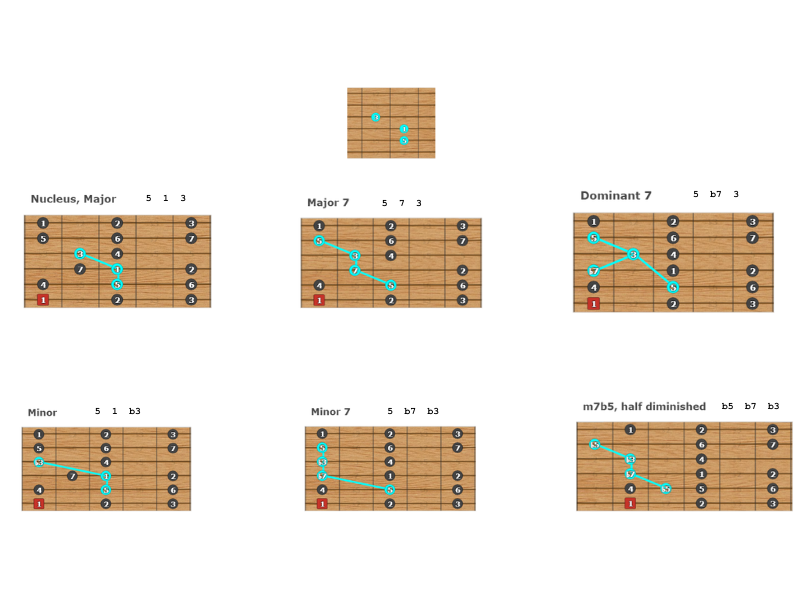
Chord types constructed by modifying the core – nucleus 5 – 1 – 3
The numbers 5 – 1- 3 are tones making chord major. To create other types, different quality, such as minor, we modify the numbers. There is an easy formula to do so, by making certain tones/numbers “smaller or bigger” .
For example for minor chords we need to modify the 3 – making in half a step smaller. The resulting numbers – tones then are 5 – 1 – b3 (flat three)
The image shows chord types naturally occurring in major scale:
Major, minor, dominant 7 and m7b5 plus major7 and minor7 chord types.
They are created by modifying E major shape.
The frets where the red 1 is (the root) you would cover with bare or you don’t play it, but then you only use the tones from the shape (3 or 4 fingers)

Uncover the fretboards potential and unlock yours.
Schedule coaching now
The E-System and Guitar Syntax
is the key that unlocks the fretboard for you, utilizing building blocks presented – The E-System.
We create conceptual map for any key and with few rules/instruction regarding numbers and shapes, we can move freely across the entire neck, selecting chord types, scales and modes easily.
Benefits
Get beyond the Boxes
You’ve probably learned a bunch of chord shapes and scales in specific positions. The E-System encourages /allows you to think beyond those boxes and see how everything connects across the entire fretboard. It helps you break free from the limitations of memorizing fingerings out of context, and allows you to move around the fretboard with greater freedom and logic.
Master chord construction
Maybe you already know the basic building blocks of chords (root, third, fifth). The E-System helps you see how those building blocks are arranged in different chord shapes and how you can modify them to create variations. It identifies only five major chord shapes related to the guitar strings. Each shape is constructed with a “nucleus,” a core grouping of three notes configured as 5-1-3 or 1-3-1. This core/nucleus serves as a flexible starting point for customizing and creating various chord types. It gives you a deeper understanding of chord construction. It allows you to create and explore!
Unlock the Fretboard
Instead of memorizing dots, you will use the E-System to find /figure out whatever you need on the fretboard. This frees you to improvise with confidence and move around the fretboard with ease.
Explore Modes
A unique aspect of the E-System is how it assigns numbers 1 through 7 as starting points for the modes of the major scale, making them even more accessible. You do not need to remember all the flats and sharps, you only need to know what mode starts with what number. This opens up a world of new musical possibilities and helps you create more interesting and nuanced melodies.
Key Takeaways
Simplicity
The E-System aims to demystify the fretboard by eliminating the necessity to memorize countless specific finger positions out of context. It encourages learners to focus on interconnectedness.
Understanding
This approach is strongly focused on logic and understanding over mere pattern and chord memorization. By focusing on the numbers/intervals, you gain a greater insight into how music is constructed and can be manipulated – specifically for the guitar fretboard. It is guitar oriented theory, not music theory for keyboard/piano placed over the fretboard.
Flexibility
The E-System’s foundational concepts allows you to create an extensive array of chords and melodies. Understanding the foundational building blocks paves the way for creative expression and innovation.